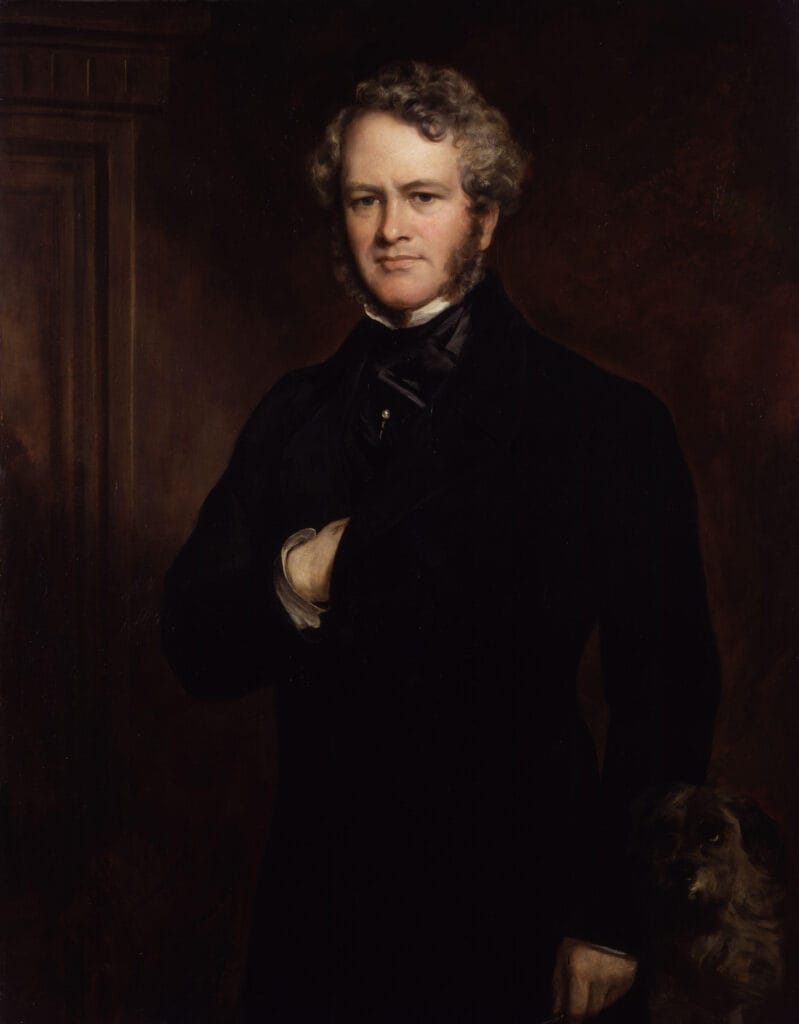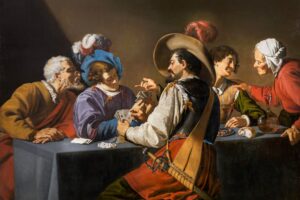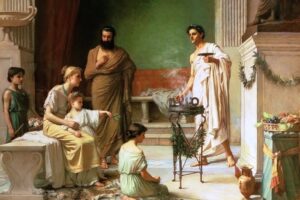Low Life and High Life – Edwin Landseer, 1829
Two dogs. Two lives. Two separate paintings — yet forever paired in the heart of Victorian art. In 1829, the young British artist Sir Edwin Landseer painted Low Life and High Life as companion pieces. Though each stands alone on its own canvas, together they tell a quiet, profound story of contrast, class, and shared dignity.
Landseer, beloved for his lifelike animal portraits, gives us no humans here — only two dogs, each waiting in silence. But through these animals, he offers a social mirror, one that still reflects across time.
The Scene Before Us
In Low Life, a white-and-tan bulldog sits at the edge of a dim, rough-hewn space — perhaps a stable or cellar. The floor is strewn with straw. A dented jug rests nearby. The dog, stout and steady, leans into the cool stone with a calm, resigned gaze. His collar is thick, practical. There is no decoration, only duty.
In High Life, a sleek terrier — or perhaps a deerhound — sits at the edge of a richly appointed chamber. Velvet drapes, brass candlesticks, an armchair, scattered papers — every object hints at refinement and wealth. Light pours softly through a leaded-glass window, illuminating the dog’s poised figure. He too waits, alert but composed.
Though the dogs differ, their expressions echo one another. Each waits by a door. Each is loyal. Each holds his place with quiet pride.
The Deeper Meaning
Landseer’s genius lies not in creating contrast for spectacle, but in revealing a deeper truth: that love, devotion, and presence exist in all walks of life. He does not mock the bulldog’s coarse setting, nor does he glorify the terrier’s luxury. Instead, he observes both with tenderness.
These paintings are not just about dogs — they are about people. About Victorian England’s rigid class divide. About the illusion that status determines value. About the quiet nobility of those who serve without fanfare.
That the animals sit without masters in view makes the message clearer still: the dogs are waiting, as we all do — for care, for connection, for someone to return. And in that waiting, they are the same.
A Moment Caught in Time
Though painted on two separate canvases, Low Life and High Life are forever linked. They are often displayed side by side, as Landseer likely intended — a visual conversation about place, power, and spirit.
And while much has changed since 1829, the story these dogs tell has not. We still judge by setting. We still sort by class. But Landseer’s work gently asks: What if dignity lives in both places?
So we look. And we learn — not just about the world of yesterday, but about ourselves.
About Artist

Sir Edwin Henry Landseer (1802–1873) was an eminent British painter and sculptor renowned for his detailed and realistic animal paintings. Born in London, Landseer was a child prodigy who began exhibiting at the Royal Academy by age 13. He became especially famous for his ability to depict animals with expressive, almost human-like qualities, capturing their behavior and emotions with unsurpassed skill. He was a favorite of Queen Victoria, who commissioned works from him and admired his artistry.
Artist Style and Movement
Landseer’s style is rooted in the Romantic tradition with a strong emphasis on narrative and emotional appeal. His paintings often blend realism with sentimentality, especially in his depictions of dogs, horses, and other animals. His art reflects Victorian values and social concerns by using animals as allegories for human virtues and societal commentary. His mastery of detail and texture combined with storytelling made him the leading animal painter of his era.
Artwork Profile / Notable Works
- Low Life (1829): This small oil on wood painting depicts a white and brown terrier guarding his butcher master’s worn belongings in a modest, urban setting. The dog’s scarred appearance and the humble surroundings symbolize the rough life of the working class, using the terrier as a metaphor for loyalty amidst hardship.
- High Life (1829): The pendant to “Low Life,” this painting shows a Scottish deerhound sitting faithfully next to his wealthy owner’s armchair in a richly furnished interior. It symbolizes the aristocratic and chivalrous life. Together, “Low Life” and “High Life” contrast social classes through the portrayal of dogs in different milieus. Both paintings are held by Tate Britain, London.
- The Monarch of the Glen (1851): Among his most iconic works, this painting depicts a majestic red deer stag, symbolizing the Scottish Highlands’ wild beauty and strength.
- The Hunted Stag (1832): A dramatic and emotional forest scene representing the struggle and nobility of the natural world.
Edwin Landseer’s legacy is immense in the tradition of animal painting, where he elevated the genre through his technical mastery and evocative storytelling. His twin paintings “Low Life” and “High Life” remain celebrated for their social commentary and artistic excellence, illustrating Victorian sensibilities and class distinctions with poignancy and artistic finesse. Landseer’s works continue to influence artists and captivate audiences worldwide.ral life and the emotional bonds within families.



